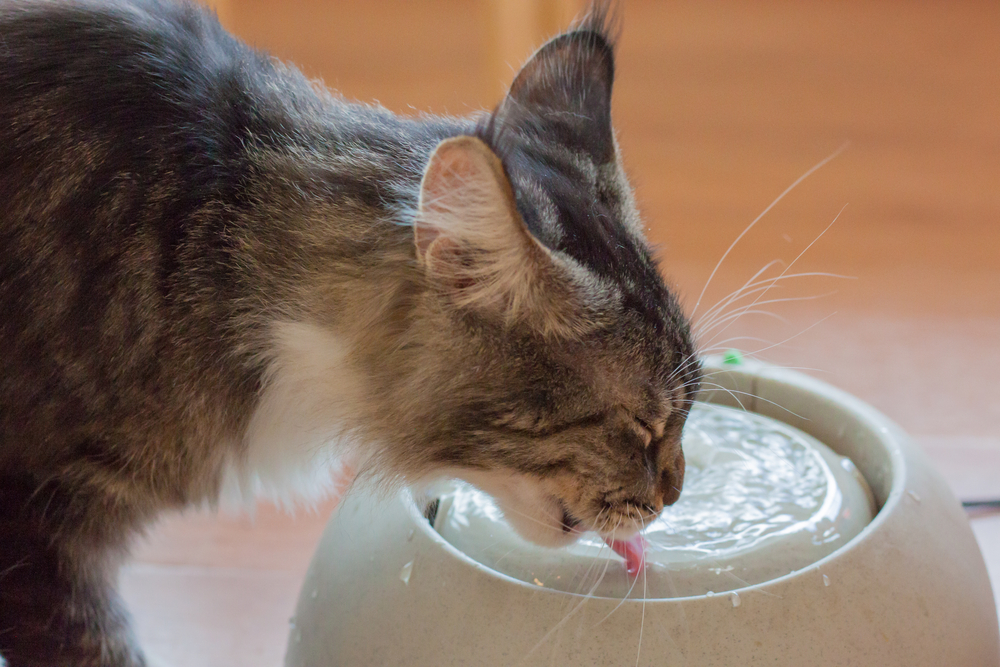Your dog’s companionship while you sit by the pool or work in your garden can be extra relaxing on a summer day, but if you fail to pay attention to your dog’s behavior and whereabouts, you may miss the signs of dangerous, and potentially fatal, heat exhaustion and heatstroke. Acorn Animal Hospital wants you to understand why pets are susceptible to the heat, to know the signs of an overheated pet, and how to prevent a desperate situation this summer.
Panting is a pet’s only chance
Dogs, and cats, when necessary, cool themselves almost exclusively by panting. While both species have sweat glands in the foot pads, these are made for traction rather than cooling.
Panting is an evaporative cooling method that relies on a deep, frequent air flow exchange by moving cooler outside air along the upper respiratory tract and through the lungs, where the cool air is traded for warm, humidified air that is expelled from the body. Dry outside air that moves across the tongue, cheeks, and nose creates an opportunity for water evaporation (i.e., more heat exchange) from the body.
When panting is not enough for your pet
Panting can be incredibly effective, but sometimes an overheated pet finds themselves fighting an uphill battle.
- High ambient humidity reduces the amount of evaporation that can take place.
- Outdoor summer temperatures may not be much lower than the pet’s internal body temperature.
- Prolonged panting is physically demanding, and can lead to dehydration if water is not available.
- Brachycephalic pets (i.e., flat-faced breeds such as pugs, French and English bulldogs, and shih tzus) have small nasal passages, and narrow airways that are sometimes collapsed, making them inefficient at cooling and at higher risk for heat-related illness.
- Recent physical exertion or fear and stress can amplify a pet’s situation.
Heat exhaustion and heatstroke in pets
Perfectly healthy dogs will normally pant in the summer, so how can you tell when an overheating pet needs help? By understanding heat exhaustion’s progressive signs in dogs and cats, you can react quickly and appropriately, before the pet can worsen or suffer heatstroke. Signs include:
- Rapid panting—the tongue may be wide and flat, to increase surface area
- Elevated heart rate and respiratory rate without exertion
- Glassy eyes or distant expression
- Restlessness
- Unusual or changed behavior
- Brick red gums
- Unsteady gait
- Panting in cats, which is uncommon, and open-mouth breathing may indicate other medical issues and the need for veterinary care.
If your pet shows these signs, move them to an indoor, air-conditioned location, wet them down with cool—never cold—water, offer cool water to drink, and promptly call Acorn Animal Hospital.
When attempts to cool your pet fail and their internal body temperature rises, their central nervous system can be affected. This connotes heatstroke, which requires immediate veterinary attention. Many pets reach this point because they were left outside without shade, or in a parked vehicle. In this progressed state, signs include:
- Lack of coordination
- Collapse or fainting
- Seizures
- Unresponsiveness
- Coma
- Death
If your pet has reached this stage, call Acorn Animal Hospital immediately. Wet down your pet with cool water, and transport them to the hospital in a cool, not chilly, car. Pets experiencing heatstroke must be carefully and gradually cooled, and closely monitored to prevent organ injury. Heatstroke victims, whose body temperature can reach as high as 107 degrees, can also suffer irreparable tissue and organ damage from a lack of blood flow as the overheated body puts its full effort into cooling. Unfortunately, the resulting bleeding disorders, and brain and cardiac damage, are fatal for some heatstroke victims.
Preventing heat-related pet illnesses
Pets can suffer heat-related illness and injury on mild summer days, too. Strenuous physical activity and a lack of acclimation contribute to many cases. Avoid putting your pet in jeopardy by remembering the following:

- Keep your pet hydrated, and provide constant access to fresh water.
- Exercise your pet in the cooler times of day, preferably early mornings.
- Keep your pet off hot surfaces, such as asphalt and artificial turf, which can burn their paw pads.
- Never leave your pet in the car—cracking the windows does not help—if the temperature is higher than 70 degrees. Temperatures can spike quickly to inhospitable digits. Many pets die every year when their owners fail to return to the car fast enough. Don’t risk it—leave your pet at home, or ensure they can go where you go.
- If you must be outdoors with your pet, ensure they have access to ample shade and water. Track the shade throughout the day, because a broad morning shadow under the trees may be only a sliver by noon.
When it comes to pets and heat, you cannot be overly cautious. Summer may not last forever, but the risks of heat-related illnesses can linger. Pets who have suffered previous heat exhaustion or heatstroke are more likely to experience them again. Consider spending peak heat hours indoors with your pet this summer—cats and dogs enjoy a good movie day like the rest of us. If you have additional concerns about heat safety and pets, don’t hesitate to contact Acorn Animal Hospital.
